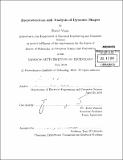| dc.contributor.advisor | Jovan Popović. | en_US |
| dc.contributor.author | Vlasic, Daniel, 1979- | en_US |
| dc.contributor.other | Massachusetts Institute of Technology. Dept. of Electrical Engineering and Computer Science. | en_US |
| dc.date.accessioned | 2011-01-26T14:29:08Z | |
| dc.date.available | 2011-01-26T14:29:08Z | |
| dc.date.copyright | 2010 | en_US |
| dc.date.issued | 2010 | en_US |
| dc.identifier.uri | http://hdl.handle.net/1721.1/60815 | |
| dc.description | Thesis (Ph. D.)--Massachusetts Institute of Technology, Dept. of Electrical Engineering and Computer Science, 2010. | en_US |
| dc.description | Cataloged from PDF version of thesis. | en_US |
| dc.description | Includes bibliographical references (p. 122-141). | en_US |
| dc.description.abstract | Motion capture has revolutionized entertainment and influenced fields as diverse as the arts, sports, and medicine. This is despite the limitation that it tracks only a small set of surface points. On the other hand, 3D scanning techniques digitize complete surfaces of static objects, but are not applicable to moving shapes. I present methods that overcome both limitations, and can obtain the moving geometry of dynamic shapes (such as people and clothes in motion) and analyze it in order to advance computer animation. Further understanding of dynamic shapes will enable various industries to enhance virtual characters, advance robot locomotion, improve sports performance, and aid in medical rehabilitation, thus directly affecting our daily lives. My methods efficiently recover much of the expressiveness of dynamic shapes from the silhouettes alone. Furthermore, the reconstruction quality is greatly improved by including surface orientations (normals). In order to make reconstruction more practical, I strive to capture dynamic shapes in their natural environment, which I do by using hybrid inertial and acoustic sensors. After capture, the reconstructed dynamic shapes are analyzed in order to enhance their utility. My algorithms then allow animators to generate novel motions, such as transferring facial performances from one actor onto another using multi-linear models. The presented research provides some of the first and most accurate reconstructions of complex moving surfaces, and is among the few approaches that establish a relationship between different dynamic shapes. | en_US |
| dc.description.statementofresponsibility | by Daniel Vlasic. | en_US |
| dc.format.extent | 141 p. | en_US |
| dc.language.iso | eng | en_US |
| dc.publisher | Massachusetts Institute of Technology | en_US |
| dc.rights | M.I.T. theses are protected by
copyright. They may be viewed from this source for any purpose, but
reproduction or distribution in any format is prohibited without written
permission. See provided URL for inquiries about permission. | en_US |
| dc.rights.uri | http://dspace.mit.edu/handle/1721.1/7582 | en_US |
| dc.subject | Electrical Engineering and Computer Science. | en_US |
| dc.title | Reconstruction and analysis of dynamic shapes | en_US |
| dc.type | Thesis | en_US |
| dc.description.degree | Ph.D. | en_US |
| dc.contributor.department | Massachusetts Institute of Technology. Department of Electrical Engineering and Computer Science | |
| dc.identifier.oclc | 696791034 | en_US |
